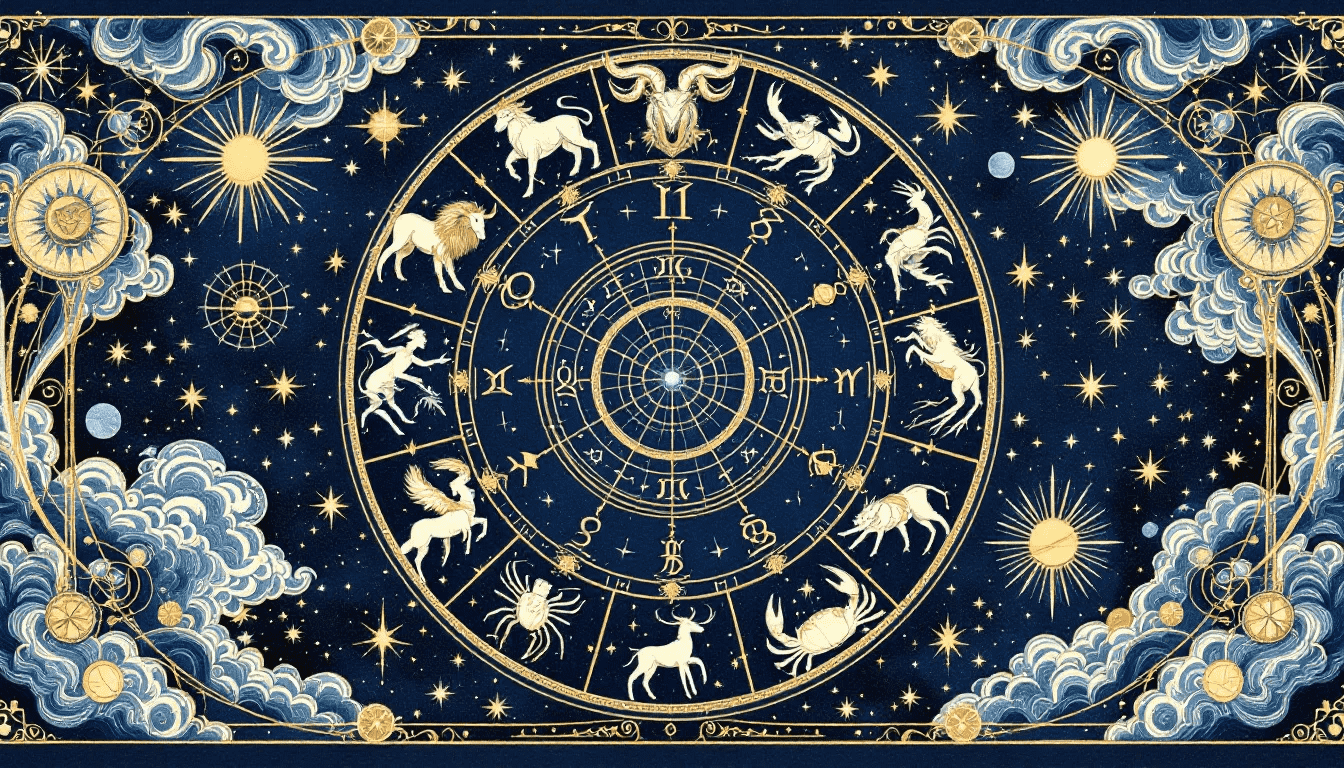Find the Significance of Astrological Ages in the Contemporary World
Aryan K | November 12, 2024

- Key Takeaways
- Defining Astrological Ages
- Historical Context of Astrological Ages
- Transitioning to the Age of Aquarius
- The Influence of Astrological Ages on Human Evolution
- Astrological Ages and Modern Times
- Summary
- Conclusion: Navigating the Stars with Deluxe Astrology's Free Birth Chart Services
- Frequently Asked Questions
Astrological ages are periods of roughly 2,160 years defined by the Sun’s position at the vernal equinox. They correspond to significant changes in society and history. In this article, we’ll explore these ages and their influence on human development.
Key Takeaways
Astrological ages, lasting approximately 2,160 years, reflect significant societal, cultural, and historical transitions as influenced by the precession of the equinoxes and the Sun’s position within zodiac signs.
Each astrological age corresponds to a zodiac sign and encapsulates distinct themes, with historical periods such as the Age of Virgo denoting agricultural advancements and the Age of Pisces marked by religious evolution. Many astrologers believe these transitions signify the dawn of a new age, bringing transformative changes in human evolution.
The anticipated transition to the Age of Aquarius is expected to bring major advancements in humanitarian ideals, technology, and social equality, significantly reshaping societal structures and collective consciousness. Many astrologers predict that this new age will challenge the status quo and open new chapters in human history.
Defining Astrological Ages
Astrological ages are long-term cycles in astrology, each spanning approximately 2,160 years. These ages are defined by the constellation the Sun occupies during the vernal equinox, a result of the Earth’s axial precession. This phenomenon, known as the precession of the equinoxes, shifts the backdrop of stars seen during the equinox, causing the Sun to slowly move through different zodiac signs over millennia.
Astrological ages have long been believed to reflect significant transitions in human society, culture, and history. Astrologers refer to these periods as they seek to draw correlations between celestial movements and societal shifts. Examining the characteristics associated with each zodiac sign reveals the prevailing themes and transformations that define each age.
From an astrological perspective, these twelve ages provide a framework for understanding cyclical patterns in human development. The Sun’s transition from one constellation to another marks the dawn of a new astrological age, accompanied by shifts in collective consciousness and societal evolution, particularly during the opening saturn square. This intricate interplay between the stars and human history, including the previous age, underscores the profound influence of astrology on our understanding of the world.
Celestial Sphere and Zodiac Signs
The celestial sphere is a conceptual model used to represent the sky, mapping the positions of stars and astronomical constellations as seen from Earth. This sphere is divided into twelve sections, each corresponding to a zodiac sign positioned along the ecliptic, the apparent path of the Sun through the celestial equator. These zodiac signs play a crucial role in astrological interpretations, influencing human experiences and societal trends.
Each zodiac sign corresponds to a distinct section of the celestial sphere, carrying unique astrological influences. For example, the sign of Pisces, associated with spirituality and transcendence, has dominated the Piscean age, shaping themes of religion and global exploration. As the Sun’s position shifts through these signs, it marks the transition from one astrological age to the next, guiding the evolution of human consciousness and societal structures.
Precession of the Equinoxes
The precession of the equinoxes is a slow, continuous movement caused by the earth’s axis rotation, completing a full cycle roughly every 26,000 years. This precession causes the vernal equinox to gradually shift westward along the ecliptic, moving through the twelve zodiac signs at a rate of approximately one degree every 72 years. As a result, each astrological age lasts about 2,160 years.
This phenomenon is crucial in defining astrological ages. As the march equinox occurs in different constellations, it heralds the dawn of a new age, bringing with it shifts in collective consciousness and societal structures. Comprehending the precession of the equinoxes helps us understand the cyclical nature of these ages and their impact on human history and evolution.
Historical Context of Astrological Ages
Astrological ages provide a unique framework for understanding historical patterns and human development. Each age aligns with a zodiac sign, reflecting significant transitions in human society, culture, and history. By examining these ages, we can draw parallels between celestial movements and societal shifts, gaining insights into how humanity has evolved over millennia.
From the Age of Virgo, marked by advancements in agriculture and communal living, to the Age of Pisces, characterized by the rise of major world religions and global discoveries, each astrological age encapsulates a distinct chapter in human history. These ages offer an astrological perspective on the cyclical nature of societal evolution, highlighting the profound influence of the stars on our world.
Age of Virgo (13900 B.C. – 10300 B.C.)
The Age of Virgo was a period of significant advancements in agricultural practices, leading to more organized food production. This era saw the transition from nomadic lifestyles to settled agricultural societies, fostering a sense of stability and community. As people began to cultivate the land and domesticate animals, these early societies laid the groundwork for future civilizations.
A notable shift to communal living enhanced cooperation and resource sharing among communities during this age. The development of stable food sources allowed for population growth and the establishment of more complex societal structures.
Virgo’s influence, associated with practicality and service, is evident in the organized and cooperative nature of these early agricultural societies.
Age of Leo (10300 B.C. – 7600 B.C.)
The Age of Leo symbolizes creativity, self-expression, and leadership. During this period, artistic expressions such as stone paintings and carvings emerged, reflecting the growing creativity of early human societies. The influence of Leo, associated with the Sun and vitality, is evident in the vibrant and expressive nature of the art from this era.
Key societal developments during the Age of Leo included:
The growth of settlements into villages and small societies
The formation of more organized social and religious structures
The early development of structured belief systems
The emergence of hierarchical structures within these early societies, reflecting the leadership qualities associated with Leo
Age of Cancer (7600 B.C. – 6200 B.C.)
The Age of Cancer saw the emergence of pottery, agriculture, and the establishment of the first cities. Spanning from 7600 B.C. to 6200 B.C., this era marked a significant shift towards permanent settlements and stable homes. The nurturing and home-oriented nature of Cancer is reflected in the development of strong familial ties and community bonds during this period.
As people settled into more permanent homes, they developed new technologies such as pottery, which played a crucial role in food storage and preparation. This age also saw the rise of early urban centers, laying the foundation for more complex societal structures. The influence of Cancer, associated with home and family, is evident in the stable and nurturing nature of these early communities.
Age of Gemini (6200 B.C. – 4300 B.C.)
The Age of Gemini saw the early development of writing systems, which revolutionized communication and information exchange. This period, known for its intellectual curiosity and adaptability, witnessed the emergence of the Proto-Indo-European language around 5000 B.C., enhancing communication across regions. The dual nature of Gemini is reflected in the diverse and dynamic advancements of this age.
Trade networks expanded significantly during the Age of Gemini, facilitating cultural exchange and economic growth. The development of early craft industries and ceramics during this era contributed to urban development and technological innovation. The influence of Gemini, associated with communication and intellectual pursuits, is evident in the advancements in writing and trade during this period.
Age of Taurus (4300 B.C. – 1700 B.C.)
The Age of Taurus is characterized by wealth, stability, and the rise of early civilizations. Significant advancements in metalworking, trade networks, and early banking systems during this period laid the foundation for economic growth and prosperity. The influence of Taurus, associated with material wealth and stability, is evident in the flourishing of civilizations such as the Sumerians, Egyptians, and Indus Valley.
Monumental constructions from the Age of Taurus include the Egyptian pyramids and Stonehenge, reflecting advancements in engineering and artistry. This era is marked by beauty, refinement, and the establishment of stable and wealthy societies. The influence of Taurus, associated with comfort and security, is evident in the luxurious and stable nature of these early civilizations.
Age of Aries (1700 B.C. – 200 B.C.)
The Age of Aries is marked by significant military advancements and empire expansion. Empires such as the Chaldeans, Assyrians, and the Greek Archaic Period thrived during this time, leading to cultural influence and territorial conquests. Aries’ influence, associated with boldness and pioneering spirit, is evident in the aggressive and expansionist nature of these empires, including the roman empire.
Key characteristics of the Age of Aries include notable military advancements and the rise of militaristic cultures, such as the Shang dynasty in China and the Olmecs in Mexico. The development of advanced weaponry and tactical formations during this era played a critical role in shaping the military strategies of these civilizations.
Age of Pisces (200 B.C. – Present)
The Age of Pisces significantly influenced the development of major world religions and spiritual movements. This era, characterized by themes of religion, spirituality, and transcendence, has seen the rise of significant cultural periods such as the Renaissance and the Age of Enlightenment. Pisces’ influence, associated with compassion and spiritual growth, is evident in the flourishing of religious and cultural movements during this age.
Significant global discoveries, such as Columbus’s discovery of the New World in 1492, occurred during the Age of Pisces, reflecting the expansive and exploratory nature of this era. The ongoing Piscean age is marked by spiritual growth and the cultivation of ideals, influencing the rise and spread of empires and the development of global cultures.
Transitioning to the Age of Aquarius

The transition from the Age of Pisces to the Age of Aquarius is believed to influence cultural trends and societal changes. Astrologers foresee significant societal upheavals and a push for social justice in the Age of Aquarius, heralding a period of enlightenment and humanitarian ideals. This transition is expected to bring about major changes in collective consciousness and social structures.
Astrologers predict that the Age of Aquarius will foster humanitarian ideals and advancements in technology, shaping a future characterized by innovation and social equality. Moving away from the Piscean age of spirituality and exploration, the Age of Aquarius promises a new era of progress and collective growth.
Characteristics of Aquarius
The Age of Aquarius is expected to highlight themes of innovation, humanitarianism, and social equality. Associated with the zodiac sign of Aquarius, this era will emphasize the importance of community, technological advancements, and progressive ideals. Aquarius, known for its forward-thinking and revolutionary nature, will shape modern society in profound ways.
Significant advancements in science and technology from 1950 to 1965 helped usher in the nuclear and space ages. These developments reflect the innovative and humanitarian spirit of Aquarius, setting the stage for a future of rapid technological growth and social progress.
Timing and Debate
Astrologers continue to debate the exact start date of the Age of Aquarius. Estimates vary significantly, with some astrologers suggesting it began in the early 20th century, while others propose it could begin as late as the 36th century. The debate reflects the significance of the transition and the challenges in pinpointing an exact start date due to the gradual nature of astrological shifts.
Discussions continue around the timing and significance of the Age of Aquarius, highlighting the complexities and nuances of astrological interpretations across various cultures. Despite these differing opinions, the influence of Aquarius on contemporary society is increasingly evident, shaping our collective consciousness and societal structures. Most astrologers agree that the march equinox plays a crucial role in determining these transitions, as it marks the Sun’s position relative to the Earth and initiates the start of a new astrological age. This profound influence of the celestial sphere on human life underscores the interconnectedness of astrology, cultural evolution, and the continuous journey of life on Earth.
The Influence of Astrological Ages on Human Evolution
Astrological ages are thought to parallel significant changes in human society, culture, and history. These cycles provide a deeper understanding of how historical patterns and human interactions evolve over time. Each age reflects the dominant themes and characteristics of its corresponding zodiac sign, influencing human evolution and societal development.
Transitions from one astrological age to the next bring shifts in collective consciousness and social structures. The Age of Taurus, for example, was marked by economic developments such as early banking systems and monumental constructions. Similarly, the Age of Pisces saw the rise of major world religions and spiritual movements.
These transitions underscore the profound impact of astrological cycles on human history and evolution.
Family Life and Societal Structures
Family dynamics have transformed throughout astrological ages, mirroring shifts in roles and social expectations. During the Age of Cancer, for instance, matriarchal societies emerged, emphasizing the nurturing and protective qualities associated with this zodiac sign. As human settlements became more permanent, the evolution of family dynamics led to more complex societal structures.
Each astrological age brings changes in family life and societal roles, influenced by the prevailing themes of the zodiac signs. The Age of Leo, characterized by leadership and self-expression, saw the emergence of hierarchical structures within early human communities.
Approaching the Age of Aquarius, we may see the implementation of concepts like Universal Basic Income, reflecting the age’s focus on social equality and humanitarian ideals.
Major Changes and Innovations
Key advancements in agriculture, communication, and military strategy have shaped human civilization throughout astrological ages. The origins of agriculture and animal husbandry during the Age of Virgo led to the development of stable food sources and primitive farming tools. These innovations laid the foundation for future societal growth and stability.
The Age of Gemini witnessed the creation of the first writing systems and the expansion of trade networks, revolutionizing communication and commerce. Military technology and tactics advanced significantly during the Age of Aries, influencing the expansion of civilizations and shaping societal structures.
These major changes and innovations underscore the dynamic nature of human evolution in response to astrological influences.
Astrological Ages and Modern Times
Astrological ages continue to influence modern times, reflecting the ongoing evolution of human society and culture. Significant cultural and artistic movements, such as the Renaissance, emerged during the Pisces age, emphasizing themes of spirituality and exploration. As we transition into the Age of Aquarius, we see a shift toward modernity, humanitarianism, and technological advancements.
Aquarius is associated with values like community, innovation, and social equality, influencing contemporary societal trends. The current global ‘permacrisis,’ marked by political and economic uncertainty, has led many to look to astrology for insights and guidance. This connection between astrological ages and modern times highlights the enduring relevance of astrology in understanding human history and future trajectories.
Impact on Current Events
The transition to the Age of Aquarius signifies a notable drop in violence and an increase in peaceful energy worldwide. This shift mirrors the age’s focus on humanitarian ideals and social equality.
Cultural expansion during the Sagittarius phase of the Aquarius era included the birth of jazz and characterized the Roaring Twenties, highlighting the creative and progressive spirit of that period.
Post World War II, Europe, and America saw the establishment of social welfare systems aimed at better-supporting citizens, indicative of the social changes linked to the Age of Aquarius.
Economic instability, such as the devaluation of the Mexican peso in 1994, resonates with the shifts from the Age of Pisces to Aquarius, reflecting the dynamic nature of astrological influences on current events.
Future Predictions
The Age of Aquarius is anticipated to bring transformative changes, redefining societal structures and human interactions. Technological advancements such as the Internet, radio, and television emerged during the Sagittarius phase, showcasing the innovative spirit of this age. These developments indicate a future marked by interconnectedness and rapid technological growth.
Astrologers predict that the high point of the Age of Aquarius will span from 1905 to 1980, paving the way for significant advancements and societal shifts. As we move further into this age, we can expect continued progress in technology, social equality, and humanitarian ideals, shaping the future trajectory of human civilization.
Summary
In summary, astrological ages provide a profound framework for understanding the cyclical nature of human history and societal evolution. From the Age of Virgo’s agricultural advancements to the Age of Pisces’ spiritual growth, each age reflects the dominant themes of its corresponding zodiac sign. The ongoing transition to the Age of Aquarius promises to bring innovation, humanitarianism, and social equality, shaping our future in transformative ways.
As we look to the stars for guidance, we gain valuable insights into the intricate interplay between celestial movements and human history. The profound influence of astrological ages continues to shape our world, offering a unique perspective on the past, present, and future. Embracing this astrological wisdom can inspire us to navigate the challenges of our time with a deeper understanding and a sense of hope for a brighter future.
Conclusion: Navigating the Stars with Deluxe Astrology’s Free Birth Chart Services
In conclusion, understanding astrological ages provides a unique lens through which we can view the ebb and flow of human history and societal evolution. As we transition from the Age of Pisces into the Age of Aquarius, we are poised on the brink of major changes that promise to redefine our world. Whether it’s the rise of new technologies or the shift towards humanitarian ideals, the influence of the stars remains a guiding force.
To explore how these celestial patterns impact your personal journey, Deluxe Astrology offers free birth chart generation services. By examining your birth chart, you can gain insights into the cosmic influences shaping your life, helping you navigate the complexities of the modern world. Embrace the wisdom of astrology and discover your cosmic path with Deluxe Astrology today.
Frequently Asked Questions
What are astrological ages?
Astrological ages are significant cycles in astrology lasting approximately 2,160 years, determined by the constellation in which the Sun is positioned during the vernal equinox. These ages influence cultural and spiritual developments within societies over time.
How do astrological ages influence human history?
Astrological ages influence human history by mirroring significant societal and cultural shifts that align with the themes of their corresponding zodiac signs, suggesting a cyclical pattern in human development and collective consciousness.
What marks the transition between astrological ages?
The transition between astrological ages is marked by the precession of the equinoxes, which causes the Sun to shift through different zodiac signs over time. This gradual movement signifies the onset of a new astrological age.
What are the key characteristics of the Age of Aquarius?
The key characteristics of the Age of Aquarius include innovation, humanitarianism, and social equality, emphasizing advancements in technology and the collective consciousness of society.
Why is there a debate about the start date of the Age of Aquarius?
The debate about the start date of the Age of Aquarius stems from varying interpretations among astrologers, with estimates ranging from the early 20th century to the 36th century. This variance reflects differing views on astronomical and astrological calculations.
Recent Posts

The Ultimate Guide to Ace of Cups Meaning in Tarot
Aryan K | March 3, 2025

All You Need to Know About August 10 Zodiac Sign: Leo
Aryan K | March 3, 2025

August 24th Zodiac Explained: Personality, Love, Career & Astrology
Olivia Marie Rose | March 3, 2025

Top 20 Famous Aquarians Who Define the Zodiac Sign
Olivia Marie Rose | March 3, 2025

Spiritual Meaning of Lavender: Insights and Symbolism Explained
Aryan K | March 3, 2025
Topics
- Angel Numbers
- Astrology and Birth Charts
- Baby Names
- Best Astrologers
- Business
- Career
- Celebrities and Famous Personalities Astrological Profile
- Children
- Chinese Astrology
- Festivals
- Finance
- Gemstones
- Kundli
- Love
- Marriage Prediction
- Nakshatra
- Numerology
- Pets
- Rudraksha
- Spirit Animals
- Spirituality and Positivity
- Symbolism
- Tarot
- Understanding Hinduism
- Vastu
- Vedic
- Western Astrology Charts
- Yoga and Meditation
- Zodiac Sign Date Calendar
- Zodiac Signs
